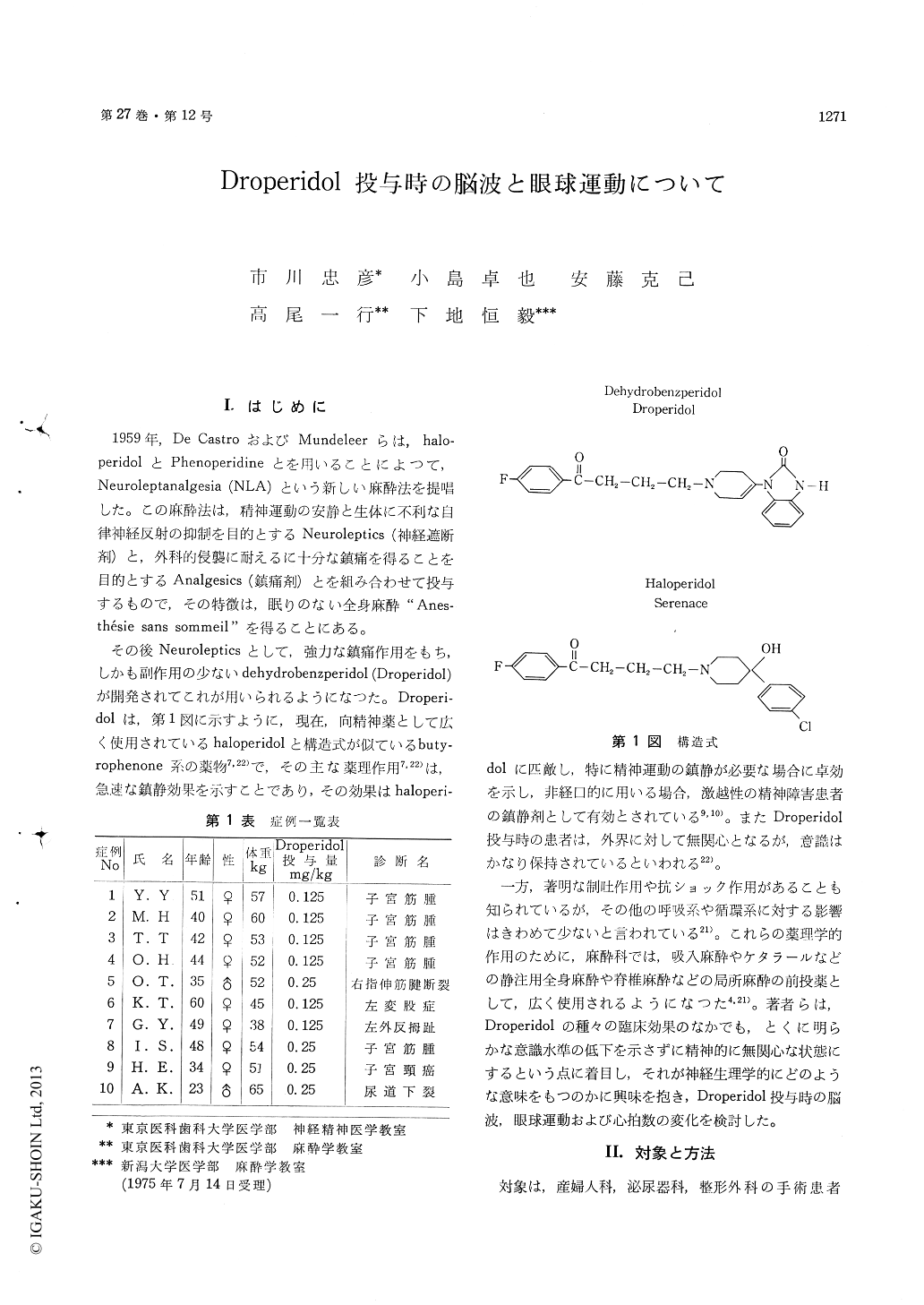Japanese
English
- 有料閲覧
- Abstract 文献概要
- 1ページ目 Look Inside
I.はじめに
1959年,De CastroおよびMundeleerらは,halo—peridolとPhenoperidineとを用いることによつて,Neuroleptanalgesia (NLA)という新しい麻酔法を提唱した。この麻酔法は,精神運動の安静と生体に不利な白律神経反射の抑制を目的とするNeuroleptics (神経遮断剤)と,外科的侵襲に耐えるに十分な鎮痛を得ることを目的とするAnalgesics (鎮痛剤)とを組み合わせて投与するもので,その特徴は,眠りのない全身麻酔"Anes—thésie sans sommeil"を得ることにある。
その後Neurolepticsとして,強力な鎮痛作用をもち,しかも副作用の少ないdehydrobenzperidol (Droperidol)が開発されてこれが用いられるようになつた。Droperi—dolは,第1図に示すように,現在,向精神薬として広く使用されているhaloperidolと構造式が似ているbuty—rophenone系の薬物7,22)で,その主な薬理作用7,22)は,急速な鎮静効果を示すことであり,その効果はhaloperi—dolに匹敵し,特に精神運動の鎮静が必要な場合に卓効を示し,非経口的に用いる場合,激越性の精神障害患者の鎮静剤として有効とされている9,10)。またDroperidol投与時の患者は,外界に対して無関心となるが,意識はかなり保持されているといわれる22)。
In order to investigate the relationship betweenthe changes of the EEG and the EOG afterdehydrobenzperidol (Droperidol, a butyrophenone-derivative) administration, 10 adults required surgicaloperation were given 0.125 mg/kg or 0.25 mg/kgof Droperidol intravenously in 0.5 minute.
Polygraphic recordings of the EEG, the EOG andthe ECG were run before and after Droperidoladministration.
On the EEG, the regularity of alpha rhythmbecame unsteady and the amount of that decreased0.5 to 1 minute after the injection, and about 20c/s fast activities increased during that period.
Two minutes after the injection the amount ofalpha rhythm slightly increased, and then 3 minutesperiod, alpha amount and regularity returned tothe base level.
The frequency and amplitude of the rapid eyemovements began to decrease soon after Droperidoladministration, and about 4 minutes later, theyall diminished and never reoccurred through 10minutes after-recording.
The heart rates temporarily increased 0.5 to 1minute after the injection, but decreased gradually,and 3 to 4 minutes returned to their base level
Although the level of consciousness was notaffected, the interest or the attention of the subjectwas slightly impaired
It appeared to be that the states following theDroperidol injection were more closely associatedwith the change of emotional aspect than that ofthe level of consciousness.
Finally, the dissociation observed between theEEG and the EOG findings might be suggested thatthese two parameters were controlled respectivelyby somewhat different brain mechanisms.

Copyright © 1975, Igaku-Shoin Ltd. All rights reserved.


